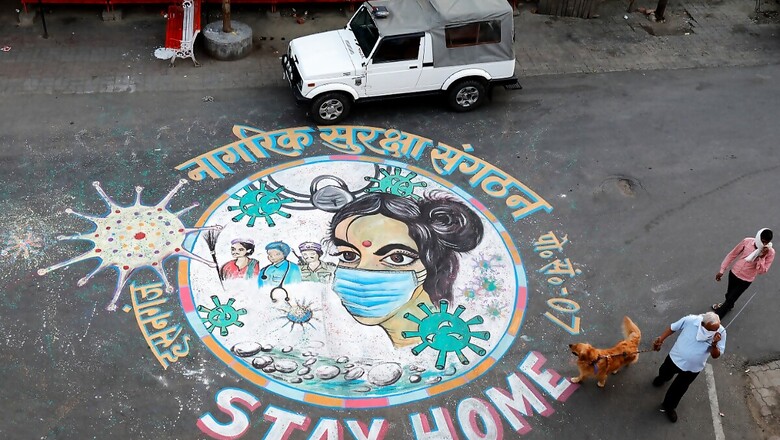
views
The mutant form of the novel coronavirus reported from Malaysia as being "10 times more infectious" is not a concern for India as it is widely prevalent here and isn't any more virulent than the strain originating in Wuhan, say scientists.
The D614G strain of the virus was discovered in Malaysia from a cluster, including a restaurant owner returning from India, the country's Director General of Health said in a Facebook post this week. His assertion that it was "found to be 10 times more infectious and is easily spread by an individual super spreader" created a flutter but scientists here dispelled fears and said there is nothing to worry about.
According to virologist Upasana Ray, the mutation may have just been reported in Malaysia but is not new for the world.
"We saw it happening in April and it eventually dominated many countries. It is new for Malaysia but is not a new mutation," the senior scientist at Kolkata's CSIR-Indian Institute of Chemical Biology said.
While some reports claim the mutation is capable of enhancing the infectivity of the virus, this is not well established and also does not necessarily indicate more virulence or harmfulness of the disease.
Ray said even a highly infectious and transmissible variant of the virus might actually have a lesser ability to cause disease in humans.
In July, a study in the journal Cell by scientists, including Bette Korber from the Los Alamos National Laboratory in the US, noted that a variant of the novel coronavirus, dubbed 'D614G', can infect more lab-grown cells than other strains.
The study said this mutant -- in which a molecule 'aspartic acid' (denoted as D) is replaced by another building block 'glycine' (G) -- had quickly taken over as the dominant strain across the world soon after it first appeared, and grew more rapidly in lab-grown cells. This mutation is part of the spike protein that the novel coronavirus uses to enter host cells.
The strain with the D614G mutation, dubbed the 'G clade', became widely prevalent in India even as far back as April, agreed Kumar Somasundaram, professor of Microbiology and Cell Biology at the Indian Institute of Science (IISc) Bangalore.
The 'G clade', or variant, currently makes up about 70-75 per cent of the cases in India, he said.
In June, Somasundaram's team published a study in the journal Current Science, analysing hundreds of samples of the virus in India.
"Back in April, if 100 patient samples were analysed in India, 40-50 per cent of them had the G clade virus. If you look at those analysed in June, almost 95 per cent are G clade, cumulatively if you add up all the samples that have been analysed over the months, the G clade makes up 70-75 per cent of the cases in India," he explained.
While the original "wild type" of the virus from the first epicentre of the pandemic in Wuhan, China, had the D clade of the virus, much of the outbreak in India began from infected people returning from Europe with the G clade.
"In February-March, the viruses we detected in Indian patients came mainly from Europe, and to some extent from the Middle East and Oceania. And Europe, even then, had an enrichment of the G clade virus. And then this strain started growing more and more in prevalence in India," Somasundaram said.
Unlike in several other parts of the world, such as the US, where other clades were initially present, the IISc microbiologist noted that in India the G clade was more prevalent even at the onset of the outbreak.
"Because this virus can grow faster, it was able to take advantage over the other types, and it has started taking over almost completely the other strains. This is true even in the worldwide scenario where it is dominating other strains," he added.
"Over a period of time, the G clade took advantage of its ability to spread and has occupied almost 95 per cent of the infected patients at a point," Somasundaram said.
However, he explained that the strain is no different compared to the wild type virus or the other strains in terms of COVID-19 disease outcome.
"The G clade virus does not have any different impact on disease severity or outcome. So that way it is no different from the wild type." Somasundaram said.
While studies, such as the one by Korber and her team, have demonstrated that the G clade virus has the potential to infect more lab-grown cells than other strains, some virologists argue this may still may not be evidence of increased transmissibility in humans.
Scientists, including Angela Rasmussen from the Columbia Mailman School of Public Health in the US, noted in a recently published commentary in the journal Cell that while lab tests can demonstrate the ability of a virus to infect a cell in culture, "it's not clear what it means for the ability to productively transmit to a new host".
"These assays don't account for the effect of other viral or host proteins and the parade of biochemical host-pathogen interactions that must occur to support infection and transmission," Rasmussen and her colleagues noted.
According to Somasundaram, the mutation in the G clade virus spike protein may also not have any implications for vaccine development.
"Initially, it was implicated that a vaccine developed against the wild type virus may not work against the mutant form. But this mutation may not have any difference in terms of how the immune system recognises the virus," he said.
"The mutant S protein containing virus can also be neutralised by a vaccine developed against the wild type virus," Somasundaram explained.
Rasmussen's team also noted the same. They said antibodies generated from natural infection with the D or G clade viruses could cross-neutralise, suggesting that "the D614G mutation is unlikely to have a major impact on the efficacy of vaccines currently in the pipeline".




















Comments
0 comment